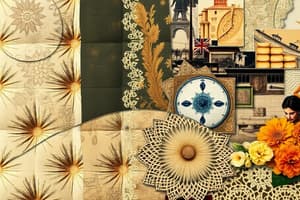Podcast
Questions and Answers
What materials can be used in braiding that are not typically used in weaving?
What materials can be used in braiding that are not typically used in weaving?
- Only natural fibers
- Straws and strips of fabric (correct)
- Only yarns
- Metal wires
Which of the following is a characteristic of braided fabrics?
Which of the following is a characteristic of braided fabrics?
- They cannot be dyed or printed
- They have a wide width
- They offer a good covering effect (correct)
- They can be produced at a high cost
For what purpose can tubular braided fabrics be utilized?
For what purpose can tubular braided fabrics be utilized?
- Producing hose pipes and ropes (correct)
- Making intricate designs for clothing
- Creating hats and accessories
- Crafting structural components
What advantage do braided fabrics have concerning production?
What advantage do braided fabrics have concerning production?
Which item is NOT commonly made from braided fabrics?
Which item is NOT commonly made from braided fabrics?
What effect does dyeing and printing have on braided fabrics?
What effect does dyeing and printing have on braided fabrics?
What is the primary material used for the foundation cloth in tufted fabrics?
What is the primary material used for the foundation cloth in tufted fabrics?
What characteristic is NOT associated with tufted fabrics?
What characteristic is NOT associated with tufted fabrics?
Which description is true about the production of tufted fabrics?
Which description is true about the production of tufted fabrics?
What is a common use for tufted fabrics?
What is a common use for tufted fabrics?
Why is dyeing and printing difficult on tufted fabrics?
Why is dyeing and printing difficult on tufted fabrics?
Which of the following is a characteristic of laced fabrics?
Which of the following is a characteristic of laced fabrics?
What can be inferred about the repairability of tufts in tufted fabrics?
What can be inferred about the repairability of tufts in tufted fabrics?
Which of the following is NOT a use of tufted fabrics?
Which of the following is NOT a use of tufted fabrics?
Which method is NOT used for intermeshing yarns?
Which method is NOT used for intermeshing yarns?
What distinguishes 'Real Lace' from lace produced by modern machines?
What distinguishes 'Real Lace' from lace produced by modern machines?
What is a primary characteristic of laced fabrics?
What is a primary characteristic of laced fabrics?
Which of the following products is NOT typically made from laced fabrics?
Which of the following products is NOT typically made from laced fabrics?
Which statement about braiding is correct?
Which statement about braiding is correct?
How does the interlacement in weaving differ from that in braiding?
How does the interlacement in weaving differ from that in braiding?
What is a potential challenge of using laced fabrics?
What is a potential challenge of using laced fabrics?
Which of the following methods involves the use of a shuttle?
Which of the following methods involves the use of a shuttle?
Flashcards are hidden until you start studying
Study Notes
Tufted Fabrics
- Composed of foundation cloth (commonly cotton, wool, or jute) and tufts.
- The foundation cloth is typically woven in a plain weave or open structure.
- Tufts are inserted into the foundation cloth’s open spaces using machines or by hand.
- Characteristics include softness, low tensile strength, and bulkiness.
- Production is time-consuming; tufts are dyed before insertion for color effects.
- Limited design capabilities; difficulty in dyeing and printing.
- Common applications include carpets, rugs, mats, bed covers, and decorative fabrics.
Laced Fabrics
- Openwork fabric formed through intermeshing yarns by various techniques: needle point, pillow lace, tatting, and crochet.
- Historically handmade until the invention of an automatic lace machine in the early 1800s, which decreased production costs.
- Known as "Real Lace," handmade versions are time-intensive and costly.
- Features low coverage, high elasticity, and similarity to knitted fabrics.
- Dyeing is feasible, but printing is not.
- Used in shawls, scarves, curtain fabrics, and decorative textiles, as well as fishing nets.
Braided Fabrics
- Created through braiding or plaiting, where three or more yarns are interwoven.
- Can also utilize cut fabric strips or straw in the braiding process.
- Similar structural characteristics to woven fabrics, yet have narrower widths.
- Distinctions from weaving: requires three or more yarns, interlaces at various angles, and can include materials beyond yarn.
- Known for good coverage, easy dyeing and printing, and cost-effective large-scale production.
- Utilized in belts, cords, shoelaces, ribbons, hats, rugs, and tubular forms for hoses and ropes.
Studying That Suits You
Use AI to generate personalized quizzes and flashcards to suit your learning preferences.

